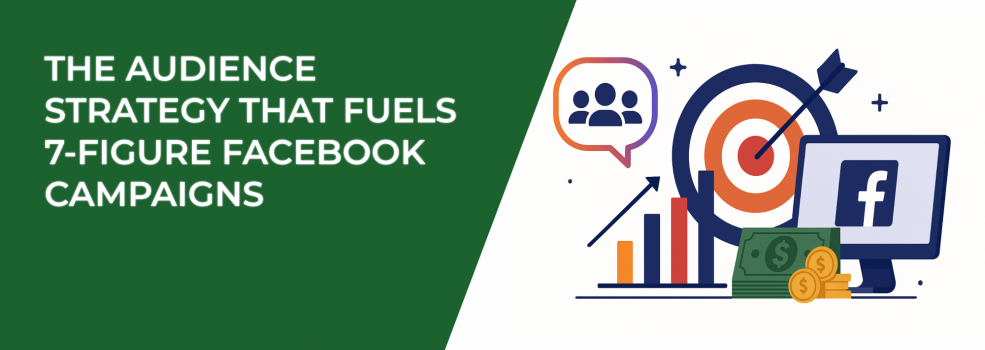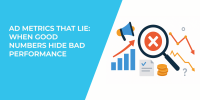Scaling a Facebook campaign to seven figures isn’t just about having a big budget. Many advertisers have spent aggressively only to watch their returns flatten out or even decline. The real difference between campaigns that break even and campaigns that explode lies in audience strategy.
A strong audience plan doesn’t only decide who sees your ad. It shapes how your message resonates, how the algorithm learns, and how sustainable your growth becomes. So, what does an audience strategy that fuels seven-figure campaigns actually look like? Let’s break it down.
1. Start with Depth, Not Breadth
Many marketers start wide, assuming more eyeballs mean more conversions. The problem? A broad audience without layers of qualification burns through budget fast. Instead, begin by stacking intent signals.
For example:
-
Build audiences from people who have visited your website in the past 30 days.
-
Segment by those who engaged with your ads or Facebook Page.
-
Narrow further with interests aligned to your product category.
This approach gives you a base audience rich in intent. Once performance stabilizes, you can expand gradually.
Think of it as digging deep into the soil before planting more seeds — strong roots grow faster when the ground is firm. For more ideas, check out Interest Stacking: A Powerful Method for Facebook Audience Segmentation.
2. Use Lookalikes Like a Scientist
Lookalike audiences are powerful, but only when the source is strong. Uploading a generic customer list gives you average results. On the other hand, creating lookalikes from your highest-value customers or biggest repeat buyers provides Facebook with a blueprint for quality.
Here’s a useful sequence:
-
Start with a 1% lookalike for high precision.
-
Test 2–3% expansions to reach scale without diluting performance.
-
Layer additional filters (like location or purchase behavior) to maintain relevance.
Experimentation matters here. Run tests with multiple seed lists, compare the results, and keep optimizing. If you want to go deeper, read Custom vs Lookalike Audiences: What Works Best for Facebook Campaigns.
3. Balance Prospecting and Retargeting
A seven-figure campaign isn’t built on retargeting alone. You can’t retarget people forever without constantly feeding the top of the funnel. At the same time, relying purely on prospecting leaves money on the table.
An effective structure might look like this:
-
60–70% Prospecting: Broad or lookalike audiences for customer acquisition.
-
30–40% Retargeting: Custom audiences of site visitors, video viewers, or cart abandoners.
The balance depends on your sales cycle, but campaigns that scale smoothly always invest in both. Ask yourself: are you feeding enough new traffic into your funnel to keep the retargeting pool alive? For a deeper guide, see How to Set Up Facebook Retargeting.
4. Target Facebook Groups and Pages
One of the most underutilized strategies in audience building is targeting specific Facebook groups and pages. These communities gather people around shared passions, industries, or interests — making them goldmines for advertisers who want relevance and intent in the same place.
Tools like LeadEnforce make this possible by allowing you to create custom audiences based on followers of competitor pages, niche groups, or industry leaders. Imagine being able to show ads directly to members of a group dedicated to home fitness, if you sell workout equipment. That’s a level of targeting precision that broad interests can’t match.
Here’s how to use this method effectively:
-
Identify groups and pages where your ideal customers are most active.
-
Build separate ad sets for these audiences to track performance clearly.
-
Rotate creative tailored to each niche. A group interested in “eco-friendly living” won’t respond the same way as a page following luxury fashion.
For more on this tactic, read How to Build Your Target Audience from a Facebook Group and Targeting Facebook Groups with Ads: What’s Possible and What’s Not.
5. Layer Audience Insights into Creative Strategy
Audiences don’t exist in isolation. The way you talk to them changes the way they respond. A video that hooks a broad cold audience may feel repetitive to someone who already visited your website.
Tailor creative like this:
-
Cold audiences: focus on problem awareness, short hooks, and value propositions.
-
Warm audiences: emphasize product benefits, reviews, or comparisons.
-
Hot audiences: highlight urgency, offers, or direct calls to action.
This layering ensures every segment feels understood — and understood audiences convert better. You can learn more in The Psychology of Facebook Ads: How to Hook Your Target Audience in Seconds.
6. Don’t Ignore Data Feedback Loops
Scaling requires feedback. The Facebook algorithm relies on consistent signals to optimize delivery. When you have a messy mix of audiences overlapping or competing with each other, the algorithm struggles.
Practical steps:
-
Exclude overlapping audiences to avoid cannibalization.
-
Consolidate small audiences into larger ad sets for stable delivery.
-
Use campaign budget optimization (CBO) once you’ve tested audience quality at the ad set level.
These adjustments may not feel glamorous, but they’re what keep campaigns stable at scale. If you’re struggling with overlap, check The Role of Audience Overlap in Facebook Ads Performance.
7. Keep Expanding with Contextual Testing
What happens when your winning audience saturates? Performance drops. That’s why audience strategy must be dynamic.
Try running contextual tests:
-
New geographies where customer demand is rising.
-
Adjacent interest groups that align with your product.
-
Lookalikes based on secondary actions like high engagement, not just purchases.
Each new test extends your runway. Without fresh inputs, even the best campaign will plateau. To explore scaling further, check The Science of Scaling Facebook Ads Without Killing Performance.
Final Thoughts
Seven-figure Facebook campaigns aren’t accidents. They’re the product of a deliberate audience strategy — one that combines intent-rich bases, disciplined testing, and ongoing expansion.
If you want scale, ask yourself: is my campaign reaching people who actually want what I’m offering, or am I just paying for impressions? The answer can mean the difference between a campaign that fades out and one that becomes a growth engine.

